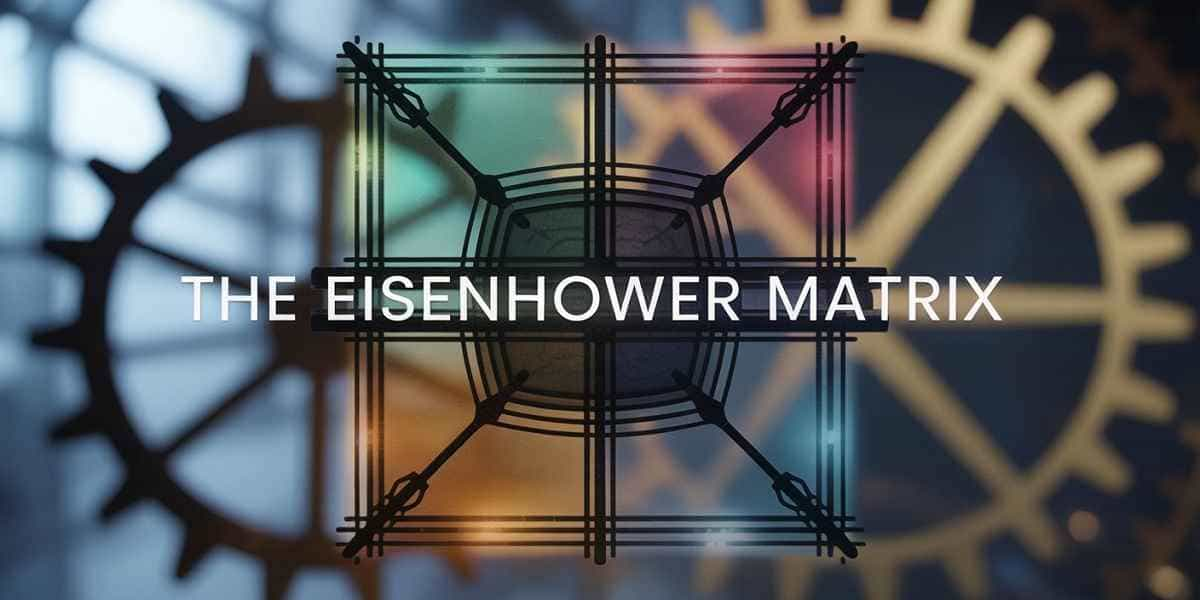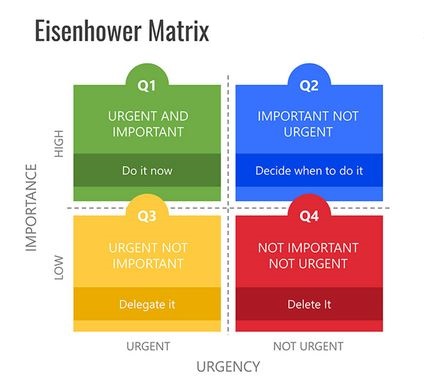
What is the Eisenhower Matrix?
The Eisenhower Matrix is a decision-making tool that helps individuals prioritize tasks based on their urgency and importance. The matrix consists of four quadrants.
Quadrant 1. – Urgent & Important: Tasks that are both urgent and important should be tackled immediately.
Quadrant 2. – Important but Not Urgent: Tasks that are important but not urgent should be scheduled for later.
Quadrant 3. – Urgent but Not Important: Tasks that are urgent but not important can be delegated to others.
Quadrant 4. – Neither Urgent Nor Important: Tasks that are neither urgent nor important should be eliminated or minimized.
By categorizing tasks into these four quadrants, individuals can focus on what truly matters and avoid getting overwhelmed by less critical activities.
Who was Dwight D. Eisenhower?
Before we delve into the Eisenhower Matrix, let’s first understand who Dwight D. Eisenhower was.
Dwight D. Eisenhower, also known as Ike, was a five-star general in the United States Army during World War II and served as the 34th President of the United States from 1953 to 1961.
Eisenhower was known for his exceptional leadership skills and strategic thinking, which later influenced the development of the Eisenhower Matrix.
Benefits of using The Eisenhower Matrix
The Eisenhower Matrix offers several benefits, including increased productivity, reduced stress and better decision-making.
By prioritizing tasks effectively, individuals can make the most of their time and energy, leading to a more balanced and fulfilling life.
How to use the Eisenhower Matrix
Productivity expert James Clear suggests a straightforward framework for comprehending the elements within each of the four quadrants: Do, Decide, Delegate and Don’t Do (or Delete).
Begin by addressing the tasks in Quadrant 1. These are matters that are both urgent and important, necessitating immediate action. They often encompass crises and issues with pressing deadlines, such as a fire in your cabin.
Next, determine when to handle the tasks in Quadrant 2. While these issues are crucial, they lack urgency and can be scheduled for later attention. Quadrant 2 tasks typically involve tasks that contribute to personal or professional growth or that align with long-term goals.
Delegate the tasks in Quadrant 3. Though urgent, these items can be entrusted to others as they don’t require your direct involvement. Examples include requests for assistance from colleagues or emails marked as urgent.
Lastly, discard the items in Quadrant 4. Since they are neither urgent nor important, they can often be removed from your list of priorities. Quadrant 4 tasks encompass activities like scrolling through social media or playing games, which are acceptable as leisure activities but shouldn’t overshadow more pressing matters.

Examples of tasks in each quadrant
To better understand how the Eisenhower Matrix works, let’s look at some examples of tasks in each quadrant.
Urgent & Important: Meeting a deadline for a crucial project.
Important but Not Urgent: Planning for a long-term career goal.
Urgent & Not Important: Responding to non-essential emails.
Not Urgent & Not Important: Mindlessly scrolling through social media.
By categorizing tasks in this way, individuals can prioritize effectively and make the most of their time.
Common mistakes to avoid when using the Eisenhower Matrix
While the Eisenhower Matrix is a valuable tool, there are some common mistakes to avoid.
Misjudging urgency and importance: Be clear about what truly matters.
Procrastinating on important tasks: Don’t let important tasks become urgent.
Overloading the Urgent & Important quadrant: Balance your workload to avoid burnout.
By being mindful of these pitfalls, you can make the most of the Eisenhower Matrix.
Tools and apps for implementing the Eisenhower Matrix
Several tools and apps can help individuals implement the Eisenhower Matrix effectively.
Trello: A popular project management tool that allows users to create boards for each quadrant.
Todoist: A task management app that lets users categorize tasks based on urgency and importance.
Microsoft Outlook: An email client with built-in features for prioritizing tasks.
By leveraging these tools, individuals can streamline their workflow and stay organized.
Eisenhower Matrix vs. Other time management techniques
While the Eisenhower Matrix is effective, it’s essential to consider other time management techniques as well.
Pomodoro Technique: Focuses on working in short, focused bursts with regular breaks.
Getting Things Done (GTD): Emphasizes capturing all tasks and organizing them into actionable items.
Each method has its strengths and weaknesses, so it’s essential to find the approach that works best for you.
Success stories of individuals using the Eisenhower Matrix
Many professionals have found success using the Eisenhower Matrix, citing increased productivity and reduced stress.
By prioritizing tasks effectively, individuals can achieve their goals and maintain a healthy work-life balance.
Eisenhower Matrix for personal development
Beyond task management, the Eisenhower Matrix can also be used for personal development. By setting goals and tracking progress, individuals can grow and improve in various areas of their lives.
Eisenhower Matrix for team collaboration
In a team setting, the Eisenhower Matrix can enhance collaboration and project management. By aligning on priorities and responsibilities, teams can work more efficiently and achieve better results.
Overcoming procrastination with the Eisenhower Matrix
Procrastination is a common challenge, but the Eisenhower Matrix can help individuals overcome it by breaking tasks into smaller, manageable steps.
By taking action on important tasks, individuals can avoid the trap of procrastination.
Future trends in time management and productivity
As technology continues to evolve, so too will time management techniques like the Eisenhower Matrix.
In the digital age, tools and apps will play an increasingly significant role in helping individuals stay organized and focused on their priorities.
Conclusion
In conclusion, the Eisenhower Matrix is a valuable tool for anyone looking to improve their time management skills and prioritize effectively.
By categorizing tasks based on urgency and importance, individuals can make the most of their time and energy, leading to increased productivity and reduced stress.
Whether used for personal development, team collaboration or overcoming procrastination, the Eisenhower Matrix offers a simple yet powerful framework for success.
Start implementing the matrix in your daily life today and experience the benefits for yourself.
Q&A on The Eisenhower Matrix
The Eisenhower Matrix is a popular tool for prioritizing tasks based on urgency and importance. Here are four key questions about this method.
Q1. What’s the difference between Urgent and Important?
- Urgent: Tasks that demand immediate attention due to a looming deadline or potential negative consequences if not addressed promptly. (e.g., responding to a client crisis, fixing a critical system error)
- Important: Tasks that contribute to your long-term goals and overall success, even if they don’t have a pressing deadline. (e.g., strategic planning, professional development, relationship building)
Q2. How do I categorize tasks in the Matrix?
- Urgent & Important: Do First! These are high-priority tasks requiring your immediate focus and attention. (e.g., meeting a tight deadline for a critical project)
- Not Urgent & Important: Schedule! These are important but not time-sensitive tasks. Schedule them on your calendar to ensure they get done. (e.g., exercise, learning a new skill, planning a vacation)
- Urgent & Not Important: Delegate or Eliminate! These tasks may feel pressing but don’t contribute significantly to your goals. Consider delegating them or eliminating them altogether. (e.g., responding to non-critical emails, attending a meeting that doesn’t directly impact your work)
- Not Urgent & Not Important: Eliminate! These tasks are neither urgent nor important and can be safely removed from your to-do list. (e.g., checking social media excessively, organizing outdated files)
Q3. How can I avoid getting stuck in the “Urgent Trap”?
The “Urgent Trap” occurs when you prioritize urgent yet unimportant tasks over truly important ones. To avoid this.
- Be mindful while categorizing tasks. Don’t let urgency overshadow true importance.
- Schedule time for “Important” tasks in your calendar to ensure they get done.
- Learn to say “no” to requests that are urgent but not truly relevant to your goals.
Q4. Is the Eisenhower Matrix the only prioritization tool available?
No, the Eisenhower Matrix is just one method. There are other tools like the ABC prioritization method (categorizing tasks as A: Critical, B: Important but not urgent, C: Less important) or the time management matrix (dividing tasks by time required and effort involved). The best tool depends on your individual needs and preferences.
One Comment
Leave A Comment
Categories
- Business Growth Strategies (143)
- Customer Experience and Retention (23)
- Digital Marketing and SEO (29)
- Financial Planning and Investment (25)
- Leadership and Team Management (28)
- Personal Development and Productivity (71)
- Technology and Innovations (53)
- USA Biz Growth (1)
Subscribe To Our Newsletter














Thanks for sharing. I read many of your blog posts, cool, your blog is very good.